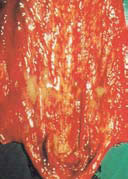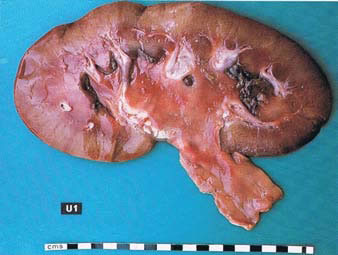 |
||||||||||||||||||||||||||||||||||||||||||||||||||||||||||||||||||||
Urinary Tract Infection (UTI) in sows - A reviewEPIDEMIOLOGY UTIs are among the most frequent bacterial infections in the herd but are not often diagnosed. They are often environmental in origin and the fecal flora obtains access to the urinary tract more easily in females than males. Under intensive confinement conditions the sows’ vulvas are often placed in direct contact with feces (SMITH, 1990). The dog-sitting position helps to force fecal material into the vagina. When the animal’s immunity is poor and the infection pressure high, bacteria can cause disease. The incidence of UTI in confinement operations increases with age, going from 18% in young sows to 38% in old sows, and is a predominant cause of death in pigs over one year of age. UTIs are more common during lactation. The lactating sow concentrates urine in an effort to conserve water, leading to higher specific gravity, and she urinates less and less frequently. This ultimately leads to higher bacterial loads as there is less urine available for flushing the urinary tract. UTI also predisposes the sow to post-partum dysgalatia syndrome (PPDS) of which MMA is considered to be a particular form. Ascending invasion of the uterus by pathogens is possible at farrowing, and the mammary glands can also be affected due to contamination of the resting area. There are several reports of identical O and K serotypes of E. coli being found in bladder, uterus and udder indicating that the micro-organisms underlying these infections are often the same (DEE, 1992). Biksi 2000 reports a strong epidemiological association between urocystitis and endometritis. Table 1: Normal bacterial flora of the female lower urogenital tract (BIKSI, 2000) * Potential urinary tract pathogens
PATHOGENESIS A thin mucus layer, glycosaminoglycan (GAG or mucin), on the bladder epithelium covers the mucosa and binds with water to form a barrier to prevent urinary constituents from coming in contact with urothelium (DEE, 1992). This layer prevents adherence of bacteria by covering possible receptor sites. Secretion of the GAG layer is under the influence of estrogen and progesterone. A defective layer can be observed in animals with urinary tract infection (WENDT, 1998; LIEBHOLD et al., 1995). In cases of significant bacteriuria, the rapid and massive appearance of goblet cells and the ensuing excessive mucus production can be interpreted as a non-specific local defence mechanism (LIEBHOLD et al., 1995). Oligosaccharides may also help detach some bound bacteria from the bladder wall (DEE, 1992). The bladder mucosa is known to have antibacterial activity due to several non-specific factors such as high osmolality, urea concentration and low urine pH. In addition, the presence of immunoglobulins such as IgG, IgA and secretory IgA in the urine and exfoliation of epithelial cells bound with bacteria aids in bacterial clearance (WENDT, 1998). It is assumed that most pathogenic agents ascend through the urethra, favored by its wide and short conformation in sows. This ascension is also enhanced by relaxation of the sphincter muscle in late pregnancy and postpartum, and the relaxation of ligaments pre-partum due to the effects of corticosteroids. Weakening of the muscle sphincter vesicae in late pregnancy and post partum, constipation, traumas to the urethra and bladder at parturition, abnormal colonization of bacteria of the sinus urogenitalis and genital organs and incomplete closure of the vulva can also predispose sows to UTIs. Other environmental and management factors can also contribute, such as assistance at farrowing, retained placenta or fluids, dirty or poorly sanitized farrowing crates and poor water flow rates or quality which leads to reduced water intake in sows, and ultimately reduced urination. A. suis is a commensal organism of the porcine urogenital tract, is fimbriated, and the short, wide urethra of the sow enhances accessibility to the bladder where the alkalinity of the environment increases because the bacteria are able to cause cleavage of urea into ammonia with the urease enzyme. The elevated pH, increased from a normal range of 6.0-7.5 to 8.0-9.0 enhances bacterial proliferation and causes an inflammatory reaction of the mucosal surface, inhibiting the growth of competitive microflora and promoting the precipitation of urinary salts and crystals, which in turn increase inflammatory changes in the bladder mucosa and provides a nest for bacterial growth and protection from antibiotics and host defence mechanisms. Dietary electrolyte balance, acid-base balance (ACB), is also a critical point to determine urine pH and thus bacterial proliferation in the urinary tract of the sow. Another consequence is a major mobilization of calcium from bones leading to a higher rate in the blood (DEROCHEY, 2000). CLINICAL SIGNS With the majority of UTIs, clinical signs are absent. However, sows with significant bacteriuria are more often seen in the dogsitting position, have inferior body condition, longer wean-to-service interval, lower fertility rates and tend to wean small litters. There may be unusual vulvar discharges, (see Table 2) with small to moderate discharge at the end of urination more frequent in older sows. Table 2: Types of vulvar discharges in female pigs.
Animals that experience late or no diagnosis frequently experience weight loss and reduced productivity secondary to end-stage renal disease, resulting in premature removal from the breeding herd. PATHOLOGY The pathology of UTIs usually comprises thickening and inflammation of the cystic mucosa, microscopically prominent goblet cell proliferation in the whole uroepithelial layer leading to necrosis inside possibly both ureters and kidneys as inflammation increases. Complications may lead to hemorrhagic kidneys with pus and excess mucus and blood in the pelvis, ureters dilated and filled with pus and the bladder wall grossly thickened inflamed and covered with excess mucus (see picture 1, 2 and 3).   Picture 2: Pyelonephritis in sow, caused by A. Suis, note the inflamed pelvis and the massively dilated ureter (SMITH,1990). DIAGNOSIS It is very difficult diagnose UTIs with a clinical examination. Bacteriology is complicated by contamination of bacteria normally present in the vagina and distal part of urethra. However, distinction between infections can be based on the number of bacteria in the urine and urine reagent sticks can be used to determine urine parameters such as pH, blood, nitrites and leukocytes. Cytology can provide information to differentiate between pyelonephritis, cystitis and bacteriuria. Also, specific gravity measurements may provide valuable information if sows have sufficient access to water. TREATMENT Even though UTIs are often asymptomatic bacteriuria events with temporary deterioration to cystitis and spontaneous remission, without therapy the infection may progress upwardly to involve ureters and then kidneys. Broad spectrum antibiotics (tetracyclines, trimethoprim sulphas, fluorquinolones) are often needed cephalosporins, penicillin, ampicillin and amoxicillin have the propensity to be excreted by the kidneys and are effective in alkaline conditions, but not against E. coli. Sulphonamides are nephrotoxic and are inactivated by pus and necrotic debris.  Table 3: Sensivity test to antibiotics for sow urine problems against E.coli, Year 2000-04 (BUSSE, 2006)
Conclusion I would like to stress that the use of specific drugs could be significantly reduced by keeping the pH of the urine inside the physiological range of 6.0 – 7.5. Recovery is sometimes possible by simply increasing access to water which leads to a natural washing and correction of the urine pH. In the case of UTIs, prevention is better than therapy and water consumption by the sow can be easily checked. Group antibiotic treatments, which are routinely provided from 2 to 5 times a year in sow units should be reduced to the absolute necessity. Instead, the acidification of sow feed, and ultimately their urine, with specific products is recommended. Particular attention should also be paid to the hygiene of farrowing and gestating crates, use of hygienic mating procedures (AI), washing of sows when transferring between facilities and minimization of sedentary behavior. A close relationship exists between the urinary pH value and the acid-base balance (ACB) of the diet (Urine pH = 3*10-6 x ACB2+ 0.003 x ACB + 6.19). Cations (Ca, Mg, Na, K) are effective in increasing the ACB while anions (P, Cl) having acidifying effects. Adding urine acidifying substances leads to a more appropriate anion-cation balance and helps maintain a healthy urinary tract. For Further Product Information Please Visit www.biomin.net |
Featured Products Biomin®pHDDecrease to IncreaseRelated Articles Biomin® pHDEffect of urinary acidifier on reproduction performance in sows Biomin® pHDUse of anions and cations in sows Biomin® pHDRRR and Biomin® pHDRelated Services Mycotoxin ChannelWorld renowned experts answer mycotoxin related questions. Mycotoxins.infoA wealth of Mycotoxin information at your fingertips. World Nutrition ForumThe future of animal nutrition | |||||||||||||||||||||||||||||||||||||||||||||||||||||||||||||||||||
|
BIOMIN Holding GmbH Industriestrasse 21, 3130 Herzogenburg, Austria/Europe ATU56585323
Tel.: +43 2782 803, Fax: +43 2782 803 30 e-mail:[email protected] |
||||||||||||||||||||||||||||||||||||||||||||||||||||||||||||||||||||




